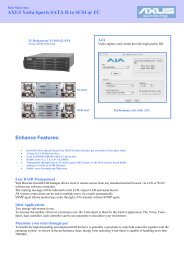WHITE PAPER Business Continuity: More than Just Waiting for ...
WHITE PAPER Business Continuity: More than Just Waiting for ...
WHITE PAPER Business Continuity: More than Just Waiting for ...
You also want an ePaper? Increase the reach of your titles
YUMPU automatically turns print PDFs into web optimized ePapers that Google loves.
THREE-TIER BUSINESS CONTINUITY:<br />
PUTTING THE PIECES TOGETHER<br />
The tragic events of September 11, 2001, as well as studies of the success and<br />
failure of disaster recovery plans in the aftermath of September 11 are driving<br />
changes in what is minimally acceptable in a sound business continuity plan. Prior to<br />
this event, secondary sites located even a few miles away were considered an<br />
acceptable option because they provided the best guarantee of rapid recovery from<br />
most common datacenter problems.<br />
Today, IT managers and regulators in specific industries are much more sensitive to<br />
the risks posed by regional disasters that can quickly knock out both the primary and<br />
secondary sites. The August 14, 2003, blackout, which affected cities and states<br />
throughout the northeast United States and parts of Canada, will further rein<strong>for</strong>ce<br />
concerns about exposure to a regional crisis.<br />
As a result, enterprises are now evaluating a three-tier strategy: primary datacenter,<br />
secondary datacenter (within 100 miles), and tertiary datacenter (several hundred to<br />
thousands of miles away). This strategy calls <strong>for</strong> a multisite cascade that combines<br />
synchronous and asynchronous replication to achieve the best of both worlds: a<br />
solution with no data loss over virtually any distance.<br />
With this option, data from the primary site is replicated synchronously to a second<br />
intermediate site nearby, creating an exact mirrored copy with complete data<br />
consistency between the two sites. Periodically, the mirrored copy in the intermediate<br />
system is suspended from its pairing to replicate it asynchronously to a recovery site<br />
that can be located virtually any distance away.<br />
The intermediate pair is then resynchronized again to make them identical, and the<br />
copy cycle to the recovery site is repeated periodically. Following a disaster at the<br />
primary site, the intermediate site contains the most current data, which can then be<br />
copied to the recovery site. The recovery site will then have the same data and<br />
consistency as if it had been in a direct synchronous remote copy session with the<br />
primary site. The ultimate goal of this approach is a current, I/O-consistent copy at the<br />
remote site that can be used <strong>for</strong> very rapid application restart.<br />
Effectively managing such a business continuity architecture will require coordinated<br />
use of many different data protection services, including local point-in-time copy,<br />
synchronous replication, and asynchronous replication. Hitachi TrueCopy and<br />
ShadowImage products are a solid foundation upon which enterprises can move to<br />
the next level of actually deploying robust business continuity solutions.<br />
COPYRIGHT NOTICE<br />
External Publication of IDC In<strong>for</strong>mation and Data — Any IDC in<strong>for</strong>mation that is to be<br />
used in advertising, press releases, or promotional materials requires prior written<br />
approval from the appropriate IDC Vice President or Country Manager. A draft of the<br />
proposed document should accompany any such request. IDC reserves the right to<br />
deny approval of external usage <strong>for</strong> any reason.<br />
Copyright 2003 IDC. Reproduction without written permission is completely <strong>for</strong>bidden.<br />
14 #3829 ©2003 IDC







